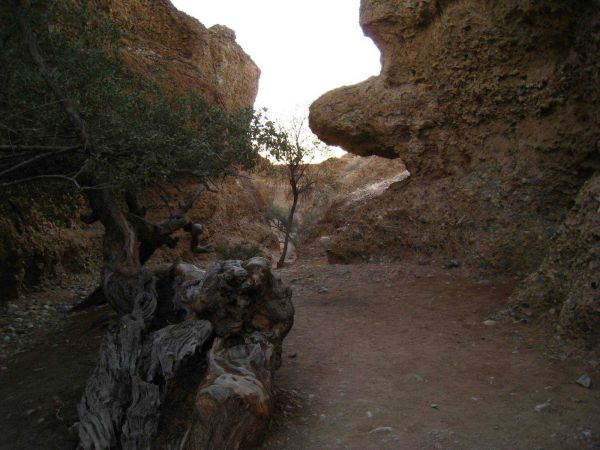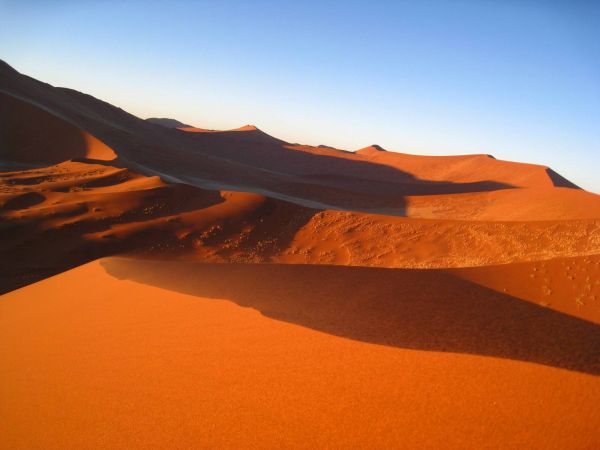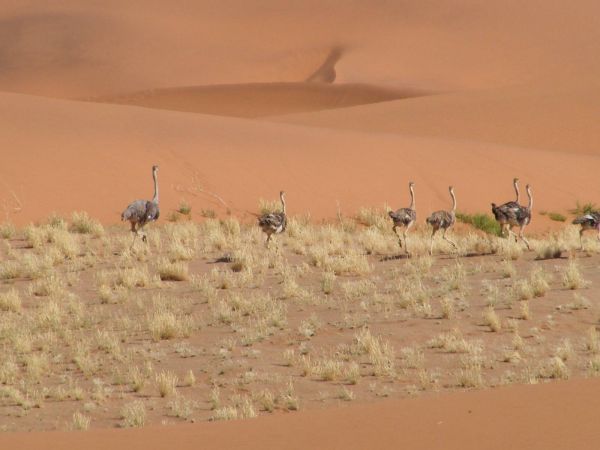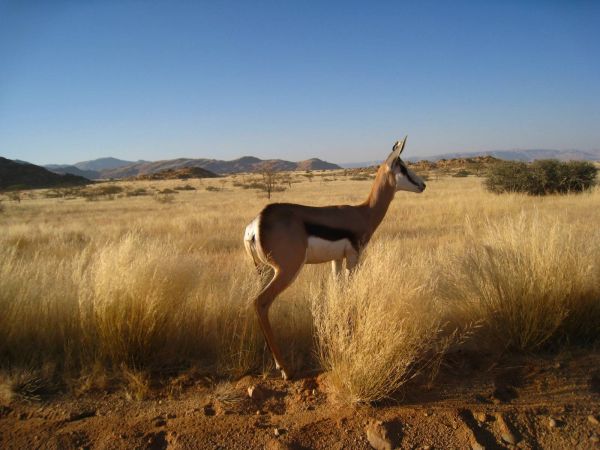
We drive northwards to get to Cape Cross. On this short rocky outgrowth, 130 kilometers north from Swakopmund, about ten thousands of seals gather. We go through the entrance gate of the reserve and a pestilential smell gets in our nostrils. We stop our car at the end of the dirt track where an improvised car park looks over a wooden footbridge. A concert of bleatings welcomes us. We can be mistaken about these animals' cry and compare it with a herd of goats' one. The comparison stops there. Thousands of dark masses fidget in front of us. In a clumsy way, the seals wriggle on the sand, attempt to climb upto the smooth rocks and it's only when they dip into the water they get back their agility and a certain grace. Despite the awkward appearance, this animal is a formidable predator since the cape fur seals that live on the Namibian and Southafrican shore gulp down more fish every year than the fishing industry of the 2 countries put together. Far from these considerations we enjoy watching these mammals, a perpetually moving picture. Not far from here, two jackals prowl around, locating some new-born young for a future feast.
The Cape Cross colony is exclusively made up of females and we shall come back for the breeding period (end of november – beginning of december) to see the 5-time-bigger males creeping out of the water. During this short season, the community outnumbers hundred thousands animals. A whole city spreading over a few hectares...


















Wednesday 25 June 2008
Seals by the thousand
By dorian on Wednesday 25 June 2008, 07:56 - RTW2-Namibia
Tuesday 24 June 2008
Along the Skeleton Coast
By dorian on Tuesday 24 June 2008, 07:49 - RTW2-Namibia
Back to the seaside where we keep on driving northwards. From the both sides of the tropic of Capricorn virtual line the animals goes on flocking to greet our visit. The sympathetic meerkat and the superb gemsbok are like shooting stars that illuminate our route. The vegetation little by little becomes scarce. The desert have taken back its land when we arrive at Walvis Bay.



We won't stay a long time in this uninteresting town. We however stop at the dune marked number 7 to devote oneself to the joys of quadbiking. With incredible gliding and skid feelings on the dunes.


As soon as we finished the quadbiking, we head for Swakopmund, the Namibian capital city for the sand- and desert-related activities. At the entrance of the city, the carcass of an old ship – the Kolmanskop – is lying on the rocks. The foam licks the hull. A boat among the others which ran aground on this frighteningly coastline over the centuries. The regular mist, strong onshore currents, sandy shallows and false luminous signals set by the miners are the factors the sailors had to make the best with to move along the Namibian shore. The numerous ships that perished in this part of Africa coined the name of this coast which is henceforth called the Skeleton coast.



After visiting Cape Cross then the scenic flight over the Namib desert (which will be the subject of my 2 next posts), we go again for a « glide session » on the sand dunes. And this time, it will be sandboarding. Exhausting and endless climb up the dune. On foot, the board wedged on the back. At the top, we coat the board with wax, we face the slope before dashing forward for a set of falls. The Namibian sand doesn't have a very good taste...
Sunday 22 June 2008
The surrealist painting of the Sossusvlei dunes
By dorian on Sunday 22 June 2008, 22:15 - RTW2-Namibia
Click on the pictures (including the panoramic views) to enlarge them.

Namibian tracks and natural curiosities meet. The road unfolds and the uncertain gravel spurts under the weight of the vehicle. A hazard roadsign indicates the skid risks and with good reason... First fright of the trip with an off-the-track escapade. The high, yellowish, sunburnt grass bends to receive us. Everyone is safe, so is the car. We arrive in a whole part at Sesriem, entrance point for the Sossusvlei dunes.



The sun sets and we cover the 4.5km standing between us and the Sesriem canyon, a little trench within the stone laying down a sandy bed. Soon, the rock outline fades and the dusk floods the small canyon with obscurity. We drive back to set up the tent at the campsite of the NWR-ran park – NWR is a national company that manages most of the national parks. And we notice the Namibian government opted for a luxury tourism since the slightest night in a lodge is between 100 and 150 euros per person and the campsite comes to 25 euros per person but that is the only way if we wish marvelling at a sunrise over the red sanddunes of this part of the Namib desert. The gate of the park stays close for the « non-residents » until 6h45, a too late time to cover the 60 kilometers from the dunes before the sun starts rising.



Wake up at 5 am, fast breakfast, we put on shorts, a tee-shirt, a polar jacket and we leave for one of the most scenic spot in Namibia, the giant dunes of Sossuvlei. The ash dark veil of the night hardly dispels we begin climbing the dune number 45. A pilling up of sand we struggle up so much our feet sink in. But what a reward at the top! Day after day, the sun rises and sets amidst total indifference. There's however sunrises which engraves on the memory forever. Here is one of them. The first rays spurt from behind the rock that blocks the horizon. From the top of our dune we contemplate the other sand-made blazing colossuses. The morning wind sweeps the silica atoms that build these huge natural walls. Behind the unpronounceable name of Sossusvlei, hide the greatest sandunes in the world, ours is about 200 meters high while others can rise beyond the 300m.
We take off our shoes to feel the warm sand giving way under our feet. Our toes split up the ridge of the sand mountain and our eyes leap from a dune to another one without weariness, the cameras crackle and the emotion overwhelms us. Meeting between the African nature and the astral light for a breathtaking chromatic patchwork.





















We keep on visiting the site and park the car at the end of the road. We yomp through a few dunes to reach Deadvlei. In the past, trees lived here but the aridity of the desert decided differently. The immortalized scene looks unreal. Trunks set in the white clay of a dried lake. It's probably in this strange place Salvador Dali drew his surrealist inspiration. We step on the dry earth while branches seems to writhe in pain in the scorching heat. 900 years the time froze the destiny of these trees. And a few centuries people marvel at. The surrounding red sand seems to respect this shrine. And the millions of particles gather together at the shore of the white expanse. The emotion still gnaws us.








Thus, an ordinary day in Namibia ends but an extraordinary one for the travelers we are.



« previous entries - page 22 of 54 - next entries »









 visits
visits